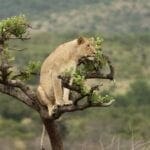Gorilla Safari in Uganda and Rwanda is an experience of a lifetime; a true privilege. Gorillas are intelligent, majestic, gentle giants that share over 90% of their genetic material with humans. Visiting the highly endangered Mountain Gorillas must be pre-booked as a limited number of permits are issued per day. Looking deep into the expressive brown eyes of the gentle giants is surely the most poignant wildlife encounter that Africa has to offer.
Mountain Gorillas cannot survive in captivity. Therefore, the only way to see the remaining approximately 1000 left on earth; is to visit them in their forest environment in the above countries. Watch as they go about their daily lives. Tending to their young. Playing and grooming each other.
About Mountain Gorillas
The fur of the mountain gorilla is often thicker and longer than that of other gorilla species. This enables them to live in colder temperatures. Hence; the reason why they are found in the misty mountains of Bwindi Impenetrable Forest in Uganda. Or, Mgahinga in southwest Uganda and Volcanoes in northwest Rwanda. They are also found in Virunga. This is in the eastern Democratic Republic of Congo (DRC) but for safety reasons; we don’t recommend it. However; you can safely visit the Western lowland gorillas in Odzala-Kokoua National Park in the Republic of Congo.
Adult males are called silverbacks. This is because a saddle of gray or silver-colored hair develops on their backs with age. The males; at a mean weight of 195 kg (430 lb) are about twice the size of females. They are active during the day and build a new nest from surrounding vegetation every night to sleep in
The mountain gorilla is highly social, and they live in groups. Group sizes vary from five to thirty individuals. A typical group contains one dominant silverback. Who is the group’s undisputed leader. Often there will be another subordinate silverback. Usually a younger brother, half brother, or even an adult son of the dominant silverback. And one or two blackbacks, who act as sentries. Plus, three to four sexually mature females. Who are usually bonded to the dominant silverback for life. And typically from three to six juveniles and infants. These groups are non-territorial; the silverback generally defends his group rather than his territory.
Where is best to visit on your gorilla safari?
The terrain in Uganda and Rwanda is pretty similar in high altitude. Whereas in Congo it is on more level ground so a lot easier. All three countries require trekking through thick rain forests. In terms of price, the rates do change. Currently, Congo is cheapest, then Uganda, then Rwanda. The Congo permits a maximum of 6 people, Uganda and Rwanda allow a maximum of 8 people per group. They all allow you an hour with the gorilla group. But it can take up to 5 hours of trekking as one never knows exactly where they are. This also depends on the fitness levels of people in the group. The minimum age is 15 years old in all 3 countries. In the Congo; trekking with a face mask is always compulsory.
What to wear for Gorilla Tracking Safari:
The most important thing is to be comfortable but the below is some ideas to aid your gorilla trekking safari:
It often rains, even in the dry season, so a light raincoat will be useful.
Sturdy walking boots with good ankle support and grip.
A light shoulder bag or a small rucksack is useful. To carry your packed lunch, water bottles, raincoat, camera and other essentials.
Local porters are also available and recommended.
Strong gloves are of enormous help, as you will be hauling yourself uphill by grabbing the bushes. And even sometimes sliding downhill on the seat of your pants!
During the track, wearing a pair of walking trousers or gaiters will prevent cuts and scratches.
Carry a water-proof plastic bag to wrap your camera and film or memory cards in.
Flash photography is strictly prohibited. As this may upset the gorillas. Make sure you bring ample supplies of high-speed film (400 ASA minimum or 800 ASA recommended). Or memory cards to counter this.
Also make sure you are completely familiar with the workings of your camera before you observe the gorillas.
Accessories: Sunscreen, sunglasses and hats are essential.
Binoculars and good cameras are an absolute must. As is mosquito repellent which most of the lodges provide.





















